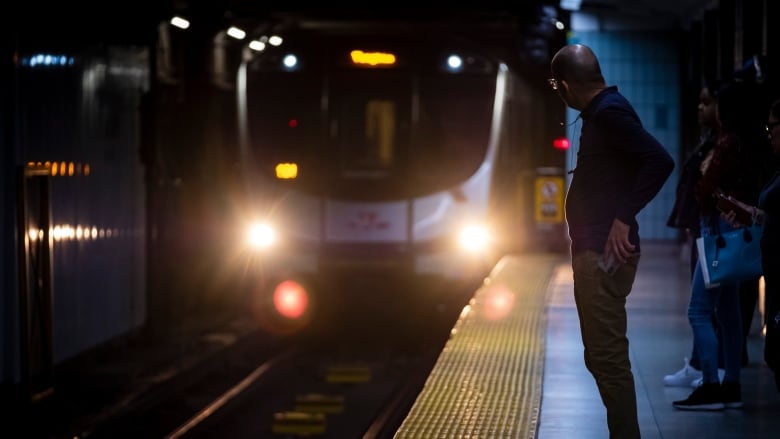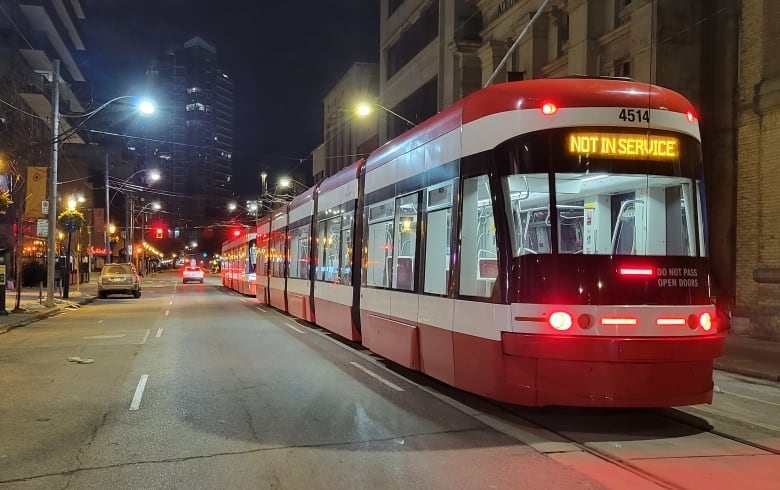Your wait for the TTC could soon get longer. Find out if your route is affected
Overall service to be set at average of 91% of pre-pandemic levels, report says

Torontonians will be waiting longer for streetcar, subway or bus service in some parts of the city this year, with the TTC set to cut service on some routes.
Overall service will be set at an average of 91 per cent of pre-pandemic levels. That'sdown from the current 96 per cent of pre-COVID service levels, according to the latest report from the Toronto Transit Commission's acting chief strategy and customer officer to the organization's board.
The transit agency says ridership in Toronto is estimated to reach 75 per cent of its pre-pandemic level by the end of this year, and it is pledging to provide reliable service that is consistent for riders. While some adjustments are set to result in shorter or similar wait times on specific routes, riders in other parts of the city will wait longer, with service suspended in some cases.
The ridership lull brought on by the pandemic "comes with consequences" in terms of the TTC's revenue stream, agency spokesperson Stuart Green told CBC News, so there have been some reductions.
"But we're doing it around the edges, we're making sure that we're preserving the busiest routes at the busiest times of day," he said.
Bus service will be impacted less than streetcar and subway service, the report says, reflectinga higher level of ridership on the city's bus network and the "need to protect surface routes that are relied upon most by equity-deserving communities."
You can read the report for a full list of affected routes here.
Fare price rises
Last month, the TTC announced a 10 cent fare hike raising single cash fares to $3.35 while also reducing services to address a $366-million budget shortfall.
Public transit systems across Canada are grappling with revenue shortfalls due to the COVID-19 pandemic and, in many cases, reduced ridership has been slower to rebound than anticipated.

But experts say solutions such as hiking fares while reducing service particularly as living costs rise is a "catch-22" that could alienate old and new riders, creating the potential for continuous financial problems and cuts.
The TTC says that on March 26, service on about 20 per cent of its routes will be adjusted while 80 per cent will remain unchanged or "temporarily adjusted" because of construction.
On Twitter, Ward 9 Coun.Alejandra Bravo slammedthe changes, especially in light of the coming fare increase.
"Riders are being asked to pay more for less service, with a 10-cent fare increase coming into effect later this year," she said. "That is unacceptable."
Route changes
Service is being changed on 37 daytime routes and two overnight routes. Of those daytime routes, customers on two routes will have shorter wait times in "some periods of the day," customers on 24 routes will have shorter wait times in some periods and longer wait times in others, and customers on 11 routes will have longer wait times, the report says.
About 31 per cent or 4.16 million of the TTC's customer boardings each week travel on the affected routes during these periods.
The transit agency says 52 per cent of its schedule changes will result in longer wait times of up to three minutes for 2,415,000 customer boardings each week, while eight per cent of schedule changes bring longer wait times between three and 11 minutes for 159,000 trips per week.
On the other side of things, 18 percent of theschedule changes will result in shorter wait times for 512,000 customer boardings each week, while another 18 per cent of the changes will result in the same wait times for some 1,038,000 customer boardings per week.
TTC staff are currently preparing the second phase of the agency's service adjustments, which are scheduled to come into effect on May 7, according to the report.
With files from The Canadian Press












_(720p).jpg)


 OFFICIAL HD MUSIC VIDEO.jpg)
.jpg)



























































































